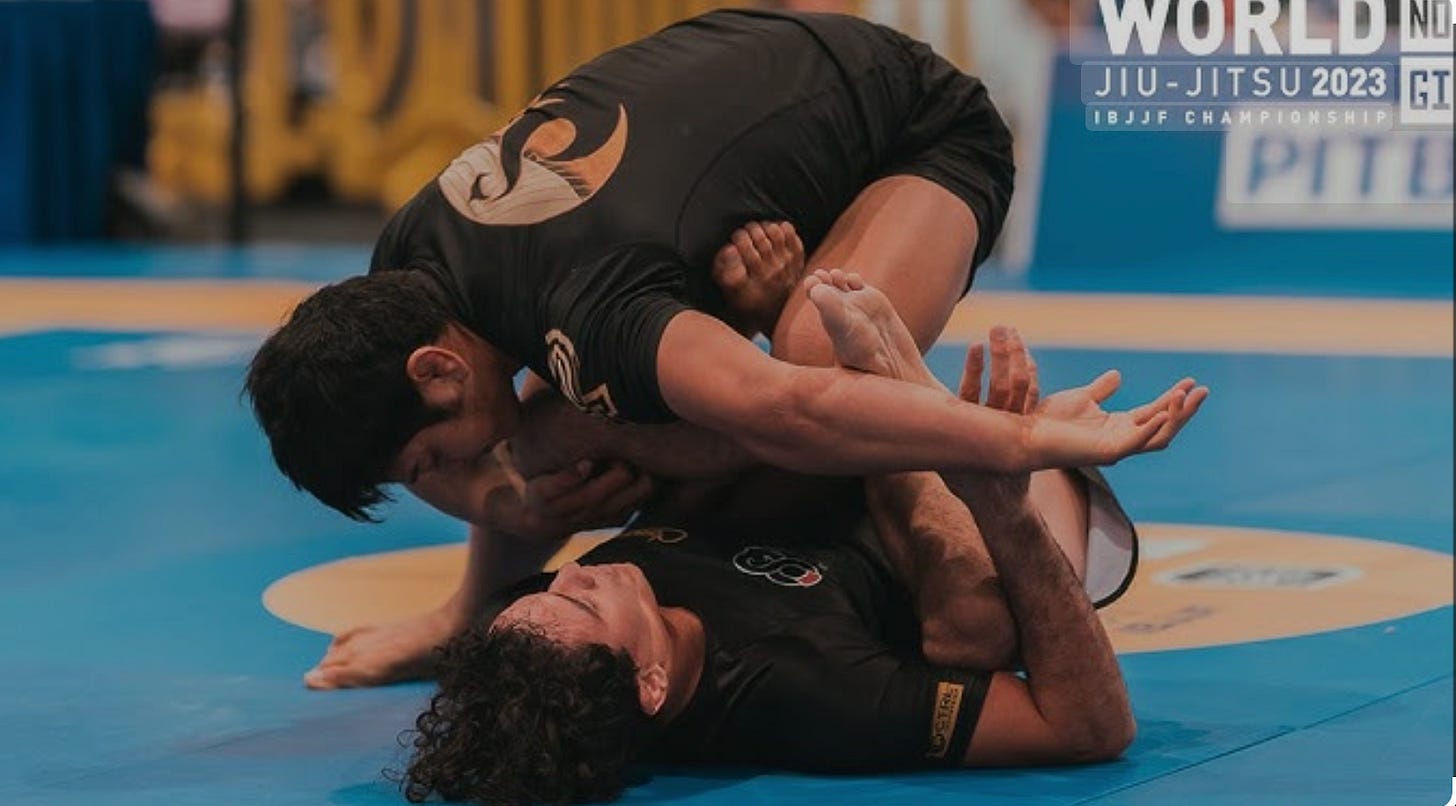ADCC Veteran, Sapateiro Champion, and Black Belt Pan American Champion Deandre Corbe moving what’s in front of him.
In Jiu-Jitsu, the job of the attacking player is to immobilize the opponent, get past their limbs, pin them to the mat, and ultimately break a limb or apply a strangle. Of course, the other player can stop this at any time by acquiescing through a physical or verbal “tap.”
Players defend themselves with a guard—placing arms and legs between themselves and the attacker to manage distance and destabilize the advancing player. The act of getting past this guard is aptly named “passing the guard.” A key concept is segmentation (Greg Souders); legendary wrestling coach Dan Gable calls it climbing the ladder.
Passing means progressively climbing the body from periphery to center. Your opponent—if they’re any good—constantly puts the obstacles of their arms, legs, and even head back in front of you to keep you from connecting to their torso.
When you’re passing somebody’s legs to hold them down, they don’t just let you—at least not anybody worth a damn. They keep putting obstacles back in front of you over and over again, looking to build momentum once this happens.
Novice players often get overly concerned with the distant target of pinning the torso and, in the heat and frustration of grappling, forget segmentation altogether. They try to jump ahead rather than securing stability at each point of demarcation.
Skilled passers, on the other hand, are aware of the distant end state but reach it by focusing on the next rung in the ladder. If they get past the knee and a knee sneaks back in, they concentrate on getting past the knees again—again, and again.
If their opponent makes progress, they return to the first rung and start climbing. This steadfast approach to continual forward progress in Jiu-Jitsu is part of what makes pressure emerge. Pressure isn’t just about size and strength; it’s about climbing your opponent one rung at a time while removing their opportunities to block you.
Move What’s In Front of You
You may ask, “What does all this Jiu-Jitsu stuff have to do with performance longevity?” I find it a beautiful metaphor for life—especially when dealing with obstacles or annoying inconveniences that stall progress toward any endeavor.
Lately, I’ve been thinking of this simply as moving what’s in front of me. When I’m on the mat, I remind myself, “Move what’s in front of you.” It helps me segment the problems more clearly and find improved success in passing the limbs that guard my training partners.
I’ve found it increasingly useful off the mat as well. When I’m working on a multi-step project or a complicated problem, I return to moving what is in front of me right then.
What is the immediate thing in my way that, if I handle it, opens the pathway to the next step?
Recently this mindset guided me while co-writing a white paper with my good friend and colleague Stu McMillan. We’ve been shaping this paper for nearly ten months, volleying ideas and edits, aiming for a final draft. Publishing a white paper is no small feat: accuracy is paramount, references must support every claim, and any incoherence can nullify larger points. In other words, it’s a lot of time, energy, and (for me) challenge.
Every time I thought There it is—we’ve got it, something needed to change: a clearer sentence, a better reference. At times the big goal felt distant.
That’s where moving what’s in front of you comes in. Rather than worry about lost ground or succumb to frustration, I did the work available that day. I moved the obstacle in front of me so we could continue—then moved the next one.
Your Ladder
I’m not usually one for cheesy calls to action, but I’m curious:
What’s right in front of you right now that you could move to reach your next step?
What strategies or thought processes help you make consistent progress?
Have you clearly defined your ladder and its rungs?
Building Pressure
By consistently moving what’s in front of you, you build steadfastness—a kind of pressure—that serves you in life. You don’t need to be a grappler to learn this (though it wouldn’t hurt!). When life blocks you and blocks you again, keep moving what’s in front of you. Eventually you’ll break through that guard and reach your goal.
Thanks for reading,
Rob
P.S. I had to move a lot out of my way to write my book Check Engine Light: Tuning Body and Mind for Performance Longevity. Give it a look!
In case you missed it I was on the Jocko Podcast Episode 495.





'What's Important Now?' - WIN I keep this question not far away from my thoughts.
‘The journey of a thousand miles begins beneath one’s feet’ - Lao Tzu.